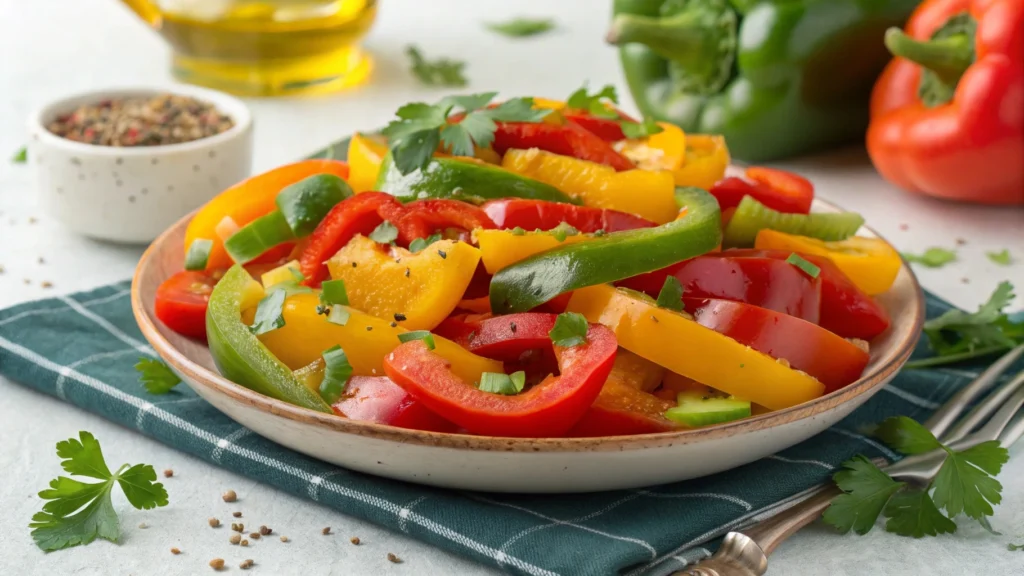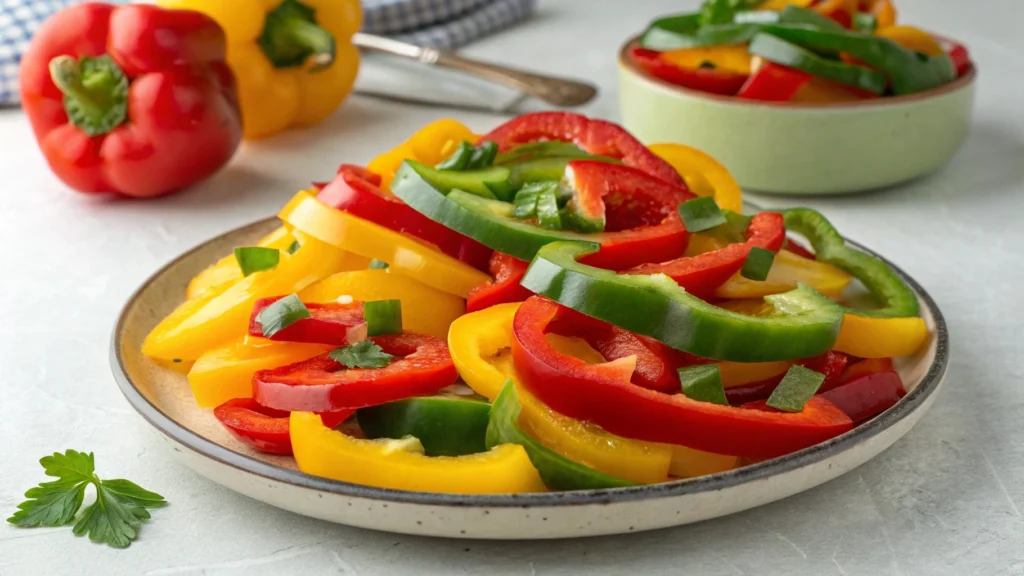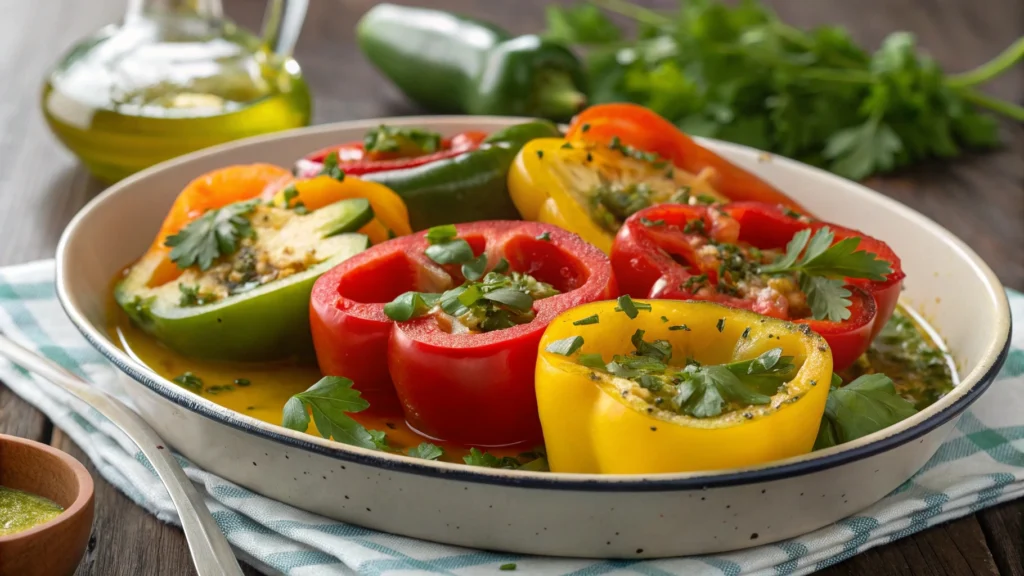Introduction – What Are Bell Peppers?

Have you ever bitten into a crisp, juicy bell peppers benefits and uses and wondered why it’s such a kitchen staple? Whether you love them raw in salads, roasted in dips, or stuffed with savory fillings, bell peppers bring color, crunch, and nutrition to every meal.
Bell peppers, also known as sweet peppers, come in a rainbow of colors—red, yellow, orange, green, and even purple. Each variety has a unique flavor profile and nutritional benefits, making them a must-have in any healthy diet.
In this ultimate guide, we’ll explore:
- The different bell pepper varieties and their best culinary uses
- The impressive health benefits of bell peppers
- Easy and delicious ways to cook with them
- Tips for growing bell peppers at home
- Fun bell pepper recipes to try
Let’s dive in and discover why bell peppers deserve a permanent spot in your kitchen!
Exploring the Different Varieties of Bell Peppers
Red, Yellow, and Orange Bell Peppers
- Taste & Color: Sweeter than green peppers, with red being the sweetest.
- Nutritional Differences:
- Red peppers have the highest vitamin C (twice as much as green).
- Orange and yellow peppers are rich in beta-carotene.
- Best Uses:
- Roasting, grilling, or eating raw in salads.
- Perfect for adding sweetness to sauces and stir-fries.
Green Bell Peppers – The All-Purpose Choice
- Taste: Slightly bitter and less sweet than colored peppers.
- Common Uses:
- Stir-fries, fajitas, stuffed peppers, and salads.
- Holds up well in long-cooking dishes.
Mini Bell Peppers and Their Growing Popularity
- Description: Small, snack-sized peppers, often sweeter.
- Health Benefits: Packed with vitamins A and C.
- Culinary Uses:
- Great for dipping, roasting whole, or adding to lunchboxes.
Specialty Bell Peppers (Purple and Italian Varieties)
- Purple Peppers: Earthy flavor, turn green when cooked.
- Italian Peppers: Long and tapered, ideal for frying or grilling.

Nutritional Benefits of Bell Peppers
Packed with Vitamin C
- One red bell pepper provides 169% of your daily vitamin C (more than an orange!).
- Supports immune health and collagen production.
Antioxidants and Fiber – A Health Powerhouse
- Rich in beta-carotene, quercetin, and lutein (protects against free radicals).
- High fiber content aids digestion and promotes gut health.
Low-Calorie and Rich in Essential Nutrients
- Only 30-40 calories per pepper.
- Contains potassium, folate, and vitamin B6.
Anti-Inflammatory Properties of Bell Peppers
- Capsaicin (in very small amounts) helps reduce inflammation.
- Supports heart health and may lower chronic disease risk.
How to Cook with Bell Peppers
Roasting and Grilling Bell Peppers for Flavor
- Method: Char over flame or roast at 400°F until skin blisters.
- Tip: Place in a sealed bag to steam—peel easily afterward.
Incorporating Bell Peppers in Stir-Fries, Salads, and Salsas
- Adds crunch to Asian stir-fries and Mediterranean salads.
- Perfect in fresh salsa or as a taco topping.
Stuffed Bell Peppers – A Classic Comfort Food
| Ingredient | Quantity |
|---|---|
| Bell Peppers | 4 large |
| Ground Turkey/Beef (or lentils) | 1 lb |
| Cooked Rice/Quinoa | 1 cup |
| Tomato Sauce | ½ cup |
| Cheese (optional) | ½ cup |
Instructions:
- Hollow out peppers and stuff with filling.
- Bake at 375°F for 25-30 minutes.
Using Bell Peppers in Soups, Sauces, and Dips
- Blends well in roasted red pepper soup.
- Enhances hummus, guacamole, and pasta sauces.
Growing Bell Peppers at Home: Tips and Tricks
The Best Conditions for Growing Bell Peppers
- Climate: Warm (70-85°F), full sun.
- Soil: Well-draining, pH 6.0-6.8.
How to Harvest Bell Peppers for Maximum Flavor
- Pick when firm and glossy (green peppers can ripen to red/yellow).
Organic Bell Peppers – Growing Without Chemicals
- Use compost and natural pest control (neem oil, companion planting).
Common Growing Issues and How to Fix Them
- Blossom end rot? Add calcium (crushed eggshells help).
- Aphids? Spray with soapy water.

Fun and Creative Bell Pepper Recipes
Colorful Bell Pepper Salad with Fresh Herbs
- Mix sliced peppers with olive oil, lemon, and parsley.
Bell Pepper Stir Fry with Tofu or Chicken
- Sauté with soy sauce, garlic, and ginger.
Vegan Stuffed Bell Peppers with Quinoa and Black Beans
- Protein-packed, gluten-free, and delicious!
Bell Pepper Frittata for Breakfast or Brunch
- Whisk eggs with diced peppers, cheese, and bake.

Conclusion – Why You Should Eat More Bell peppers benefits and uses
Bell peppers are nutrient-dense, versatile, and delicious—whether you’re roasting, stuffing, or snacking on them raw. With their immune-boosting vitamins, antioxidants, and low calories, they’re a smart addition to any diet.
Try growing your own or experiment with new recipes today!
What’s your favorite way to enjoy bell peppers? Share your recipes in the comments!
FAQ – Your Bell peppers benefits and uses Questions Answered
Are bell peppers good for weight loss?
Yes! They’re low in calories but high in fiber, keeping you full longer.
Which bell pepper is the healthiest?
Red peppers have the most vitamin C and antioxidants.
Can you eat bell peppers raw?
Absolutely! They’re great in salads, hummus, or as a crunchy snack.
How do you store bell peppers to keep them fresh?
Keep them unwashed in the fridge for up to 1-2 weeks.
